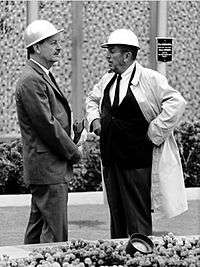John Hench

John Hench (June 29, 1908 – February 5, 2004) was an employee of The Walt Disney Company for more than 65 years, during which saw the creation of nearly every Disney animated feature and theme park.[1]
Born in Cedar Rapids, Iowa, Hench attended numerous art and creative schools across the country, including the Art Students League of New York, the Otis College of Art and Design in Los Angeles, the San Francisco Art Institute in San Francisco, and the Chouinard Art Institute in Los Angeles.
Starting in 1939 as a story artist, he weaved his way through the animation department working in areas including backgrounds, layout and art direction, effects animation and special effects. Hench was respected by Walt Disney as one of the studio's most gifted artists and teamed him with Salvador Dalí on the animated short Destino, a project begun in 1945 that was not completed and released until 2003. Hench was also Disney's "official portrait artist" of Mickey Mouse, painting the company's portraits for Mickey's 25th, 50th, 60th, 70th, and 75th birthdays.
By 1954, Hench was in the studio's live action department, as lead developer of the hydraulic giant squid in 20,000 Leagues Under the Sea, helping to win an Academy Award for Best Special Effects for the film.
Afterward, he moved to WED Enterprises (now Walt Disney Imagineering), to design attractions for the Disneyland theme park. Hench led the design for Tomorrowland, the Adventureland buildings and walkways, New Orleans Square and the Snow White Grotto. He also designed Space Mountain, and Cinderella Castle at the Magic Kingdom and Tokyo Disneyland. He also contributed to attractions such as the Mickey Mouse Revue, Carousel of Progress and It's a Small World.[2]
Because of his resemblance to Walt Disney and his frequent visits to Disney theme parks, he was often asked to sign autographs and pose for pictures with park visitors who mistook Hench for Disney himself.
One of Hench's most recognizable works is his design for the Olympic Torch for the 1960 Winter Olympics at Squaw Valley, California, modeled after the torches of the 1948 and 1956 Olympiads.[3][4] After realising that the 52 cm tall torch wasn't stable when filled with fuel, he made it slightly smaller in height and added black tape to the top part of the shaft, as it was easier for the runners to pass the torch when held near the top. In an interview, one runner mentioned that carrying the torch under the bowl made more sense than at the distal length. "It swung too much and was in your face. A short grasp was expedient!"
Hench and his wife were longtime devotees of the Hindu saint Ramakrishna and members of the Vedanta Society of Southern California.
In 1990, he received the Disney Legend award, the company's highest honor, presented to him by Michael Eisner.
Hench continued to maintain an office at Walt Disney Imagineering headquarters in Glendale, California and worked there daily up until a few weeks before his death. His name tag and 65-year service award are prominently displayed in the building's lobby, and tributes by fellow Imagineers line its hallways.
Hench died of heart failure in early 2004 after a brief hospitalization in Burbank, California.[5]
Filmography
Story
- Destino (2003)
Artist
- Fantasia (1940)
- Dumbo (1941)
- The Three Caballeros (1945)
- Fun & Fancy Free (1947)
Art Supervisor
- Make Mine Music (1946)
- The Adventures of Ichabod and Mr. Toad (1949)
- Cinderella (1950)
- Alice in Wonderland (1951)
- Peter Pan (1953)
Animation Effects
- So Dear to My Heart (1949)
- True-Life Adventure The Living Desert (1953)
Official Portrait Artist
- Mickey Mouse (1959)
Special Effects
Architect/designer
- Disneyland Tomorrowland
- Walt Disney World 1971
- EPCOT Center 1982
- Tokyo Disneyland supervisor to Oriental Land Company 1983
Author
- Designing Disney: Imagineering and the Art of the Show, 2003 Hardback/2009 Paperback, Disney Editions.
Honors
- Themed Entertainment Association Lifetime Achievement Award 1998[6]
- Disney Legend (Animation & Imagineering) 1990[7]
- Academy Award Special Effects, 20,000 Leagues Under the Sea[8][9]
Further reading
- Ghez, Didier, Walt's People Volume 1: Talking Disney With The Artists Who Knew Him, Theme Park Press, 2005 (contains 2 entire interviews with John Hench. One from 1996 conducted by Alain Littaye, and another conducted in 1999 by Didier Ghez).
- Hench, John, Designing Disney: Imagineering and the Art of the Show, Disney Editions, 2003 Hardback/2009 Paperback.
- Kurtti, Jeff, Walt Disney's Imagineering Legends and the Genesis of the Disney Theme Park, Disney Editions, 2008.
References
- ↑ https://d23.com/john-hench/
- ↑ Solomon, Charles (2004-02-06). "John Hench, 95; Disney Artist Helped Design Theme Parks". Los Angeles Times. ISSN 0458-3035. Retrieved 2015-10-21.
- ↑ BBC
- ↑ http://www.waltdisney.org/storyboard/look-closer-olympic-torch
- ↑ http://www.awn.com/news/disney-legend-john-hench-dies
- ↑ http://www.teaconnect.org/thea-recipients
- ↑ https://d23.com/john-hench/
- ↑ 20,000 Leagues Under the Sea (1954 film)
- ↑ https://www.youtube.com/embed/Okcsd-PfyS0
External links
- Hench, John; Van Pelt, Peggy (2003). Designing Disney: Imagineering and the Art of the Show. Disney Editions. ISBN 0-7868-5406-5.
- Disney Legends: John Hench
- Remembering John Hench by Matthew Walker
- John Hench: Foundations of Magic
- John Hench at the Internet Movie Database